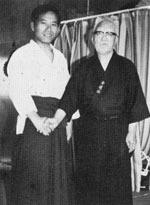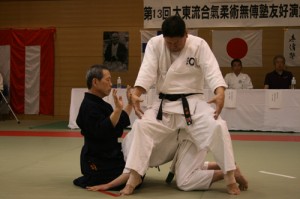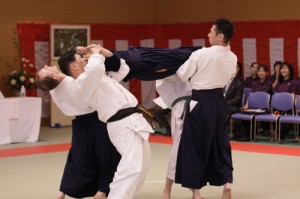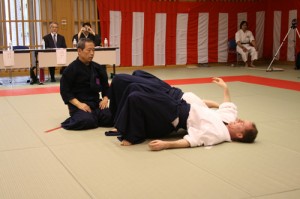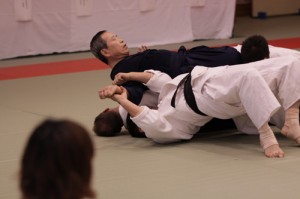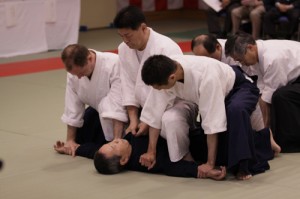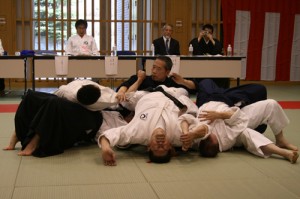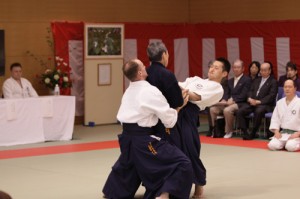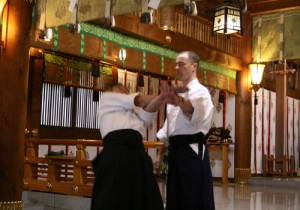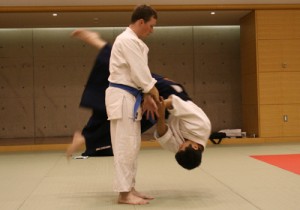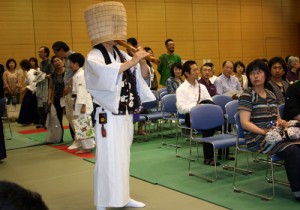不滅の合氣 三十回忌 永世名人 堀川幸道先生に捧ぐ
序章 口上
「何もしない」、これが無傳塾(うち)の技・・・
「何もしない」、これが無傳塾(うち)の流儀・・・
「何もしない」、そこにこそ合氣がある、
「不滅の合氣」がある
ただ真っ直ぐに立つ、正しく座る、それが技
ただ姿勢を正して、ゆったりと息を吸う、息を吐く、それが技
立つは技 触れれば合氣 無傳塾
先師武田惣角翁曰く、
「ほうら、簡単だろう。だから見せないのさ。」
そこに一体何があるのか。何が隠されているのか。
時には「幻の武術」と呼ばれ、時には「日本武道の精華」とも
「日本古武道の究極」とも称される、この大東流とは一体如何なるものなのか。そうして、その大東流の秘奥たる合氣とは・・・
今年、平成二十二年(二〇一〇年)は、大東流合氣柔術無傳塾開塾十周年の記念すべき年。そうして、奇しくも、大東流合氣柔術中興の祖武田惣角翁生誕百五十周年、渡道百周年の記念すべき年。
大東流とは「日出づる国」の武術。日本は世界の東の果て、極東。
北海道は日本の東の果て、そうして、網走は北海道の東の果て・・・
ここ北海道こそは近代大東流発祥の地。大東流合氣の原点。
合氣の聖地・・・
不思議な縁(えにし)、見えざる因縁の糸が感じられてならぬ。
明治四十三年(一九一〇年)、武田惣角、時の秋田県警察部長財部実秀の北海道警察部長としての赴任に際し、財部に随行、北海道に渡る。
大正二年(一九一三年)のある日、惣角は突如、飄然として湧別 の駅逓にやって来た。湧別へ来て稽古を付けてくれるよう、予てより懇願はしていたものの、よもや本当に訪ねて来ようとは思っていなかった堀川泰宗(堀川幸道の父)は驚き、狂喜した。
堀川泰宗と武田惣角翁との出会い。これこそが、正に大東流と北海道との宿命の出会いであった。
惣角翁が、湧別にて大東流を教授し始めた時、近代大東流はその産声を上げた。そうして、この嬰児(みどりご)は、多くの育ての親達に見守られながら、先ずは同じ北海道の地、遠軽、白滝へと歩みを記し、伝播し、大きく逞しく育って行った。
大正二年(一九一三年)、湧別にて、堀川泰宗入門。ここ北海道の地が、近代大東流の一大源流となる。
大正三年(一九一四年)、下湧別にて、堀川幸道(明治二十七年〜昭和五十五年)入門。後に永世名人となり、数多の弟子を育て上げ、合氣の正統・本流として大東流合氣柔術の伝統を今日に伝える。
大正四年(一九一五年)、遠軽にて、植芝盛平入門。後に合気道を創始し、世界各地へ広める。
その他、後に合氣の技を、日本全国、世界各国へと伝える数多くの弟子達が入門。その数、およそ三万と言われる。
永世名人堀川幸道先生は、大東流合氣柔術無傳塾塾長飯田宏雄の師匠である。武田惣角から堀川幸道、飯田へと脈々と受け継がれて来たこの合氣の技こそが、大東流合氣の正統・本流であり、文字通り「不滅の合氣」と称すべきものである。
我ら合氣の武術を修行する者にとって、湧別、遠軽、白滝と続く一筋の道は、謂わば、「合氣ロード」とも呼ばるべき尊い道であり、合氣の先人達が日夜修行に明け暮れたこれらの地域をこそ、「合氣の聖域」と言うも決して過言ではあるまい。 誓って
我ら合氣の正統を受け継がん
合氣の道に精進せん
合氣の修行に励まん
合氣の見えざる糸によって結ばれ、
「不滅の合氣」に導かれ・・・
▼ English
The Eternal Aiki of Kodo Horikawa Meijin.
“Do nothing.”
This contains the essence of the techniques of Daito Ryu Muden Juku.
“There is nothing.” This is the essential transmission of Muden Juku.
“It is nothing.” This is true Aiki.
What then, of techinique?
Technique consists of standing perfectly straight, or sitting upright, and, when one’s posture is correct, inhaling quietly, then exhaling.
Using this technique when standing, Aiki exists upon touch.
There is no source.
Nothing comes from without.
Sokaku Takeda Sensei said:
“You see, this is really simple, so, you should not show this.”
So what is “this” that is obscured?
Sometimes, it is referred to as “The Phantom of Martial Arts.”
It is both “The Flower of Japanese Budo.”
And
“The Origin of the Classical Martial Traditions.”
Whatever this is, it also lies at the heart of Daito Ryu Aikijujutsu.
The inner mystery of Daito Ryu is “Aiki”…
This year, 2010, marks the tenth anniversary of the founding of the Muden Juku.
It also is the 150th anniversary of the birth of Sokaku Takeda, the Art’s reviver, along with being 100 years since the Art’s first public dissemination.
Daito Ryu is an art from “The Land of the Rising Sun.”
Japan is seen as being positioned in the far east of the world.
The island of Hokkaido is located in the east of Japan, and the city of Abashiri is located in the far east of Hokkaido.
This city was the base of modern Daito Ryu, the source.
“A Twist of Fate.”
In 1910, Sokaku went to Hokkaido, the northernmost island of Japan. He accompanied Takarabe Sanehide , who had been appointed chief of the Hokkaido police, from Akita in Northern Japan, in the role of a bodyguard.
One day, in 1913, Sokaku arrived a the fishng village of Yubetsu.
He took a room at an inn ran by Taiso Horikawa, Kodo Horikawa’as Father.
Taiso was of Samurai lineage and was trained in Shibukawa Ryu jujutsu and recognised Sokaku’s level. He beaceme Sokaku’s student and thus, Daito Ryu began to be disseminated in Hokkaido.
Sokaku was invited to Yubetsu to teach by Taiso and Daito Ryu was born in its modern incarnation. This fragile incarnation was nurtured by many “parents” who practiced the Art as it spread to many other places in the Area such as Engaru and Shirataki.
Taiso became Sokaku’s student in 1913, in Yubetsu city.
The following year his son, Kodo joined the Ryu in Shimo Yubetsu
After this, for the rest of his life, Horikawa Meijin devoted himself learning and transmitting the true art and correct Aiki to his students who have carried his teachings on to today.
Morihei Ueshiba started to learn the Art in 1915. From this humble beginning, he developed the Art of Aikido which has spread across the world.
The art of Daito Ryu was admired by Martial Arts afficiandos throughout Japan. Up to 30,000 people practiced the Art and most are recorded in Sokaku’s recored books called “eimeiroku”
Due to Sokaku’s unceasing effort,relentless travelling, frmidable skills and indomitable will, the foundation of modern Daito Ryu was firmly laid across Hokkaido, including Hakodate, Sapporo, Iwamizawa and Asahikawa.
Along with this, Horikawa Meijin received the transmission of Sokaku’s “Eternal Aiki” over many years of practice and transmitted this principle to his own students.It is this principle that Hiroo Iida wishes to transmit to his students in Muden Juku.
This principle has been transmitted dierectly from Sokaku to Horikawa to Iida, indiluted and authentic.
We who follow the bujutsu of Aiki are followed a path clearde by our predessor’s unceasing efforts, day and night. From Yubetsu to Shirataki, Engaru and beyond so that
Hokkaido may truly be referred to as “The birthplace of Aiki”.
We resolve
To pass on the pure Aiki that we receive undiluted.
To follow its path without deviation.
To develop it without compromise.
This is the invisible thread that links each practicioner on the way of “Eternal Aiki.”
The Muden Juku flag’s meaning.
The name Daito Ryu (大東流) well suits the Art’s image as a Bujutsu (Martial Art) hailing from “The Land of the Rising Sun”.* The rising sun is represented as a red circle on the Japanese flag: the “Hinomaru”.
The circle represents the eternal Universe. The red represents the energy that flows from the sun.
*Translator’s note:
When written in Japanese characters, the word “Daito” is made up of two characters. The first: “Dai” 大 means great.
The second “Tou” 東 means “East” ie: The direction from where the sun rises.
